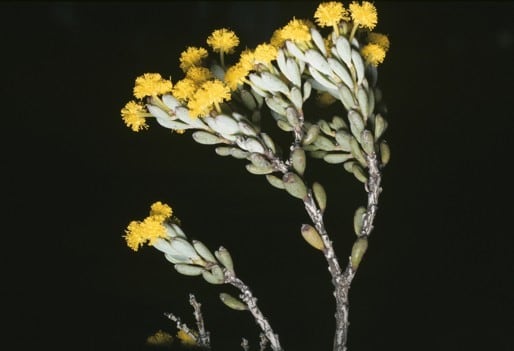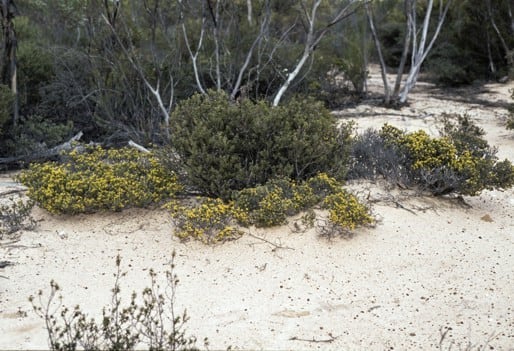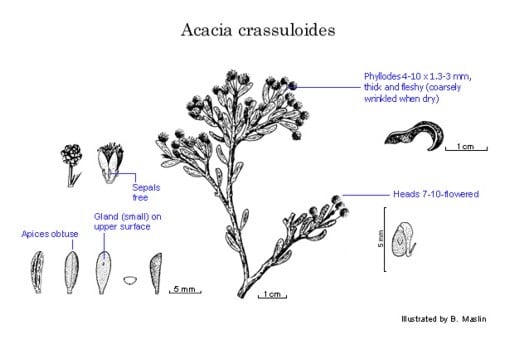Acacia crassuloides Maslin
WATTLE
Acacias of Australia
Family
Fabaceae
Distribution
Occurs from Lake King E to Salmon Gums and Mt Ney (c. 75 km NE of Esperance), south-western W.A.
Description
Glabrous multistemmed shrub to 0.5 m high, commonly forming prostrate mats. Phyllodes ascending, obovate to oblong-oblanceolate, sometimes narrowly oblong, horizontally flattened to planoconvex, 4–10 mm long, 1.3–3 mm wide, obtuse, thick and fleshy, coarsely wrinkled (dry), 1-nerved on lower surface, nerveless on upper surface; gland on upper surface above middle of phyllode, commonly absent. Inflorescences rudimentary 2‑headed racemes with axes to 0.5 mm long; peduncles 2–8 mm long; basal bracts caducous, rostriform, 1.5–2.5 mm long; heads globular, ±3 mm diam., 7–10-flowered, golden; bracteole hairs relatively long, glistening white. Flowers 5-merous; sepals free. Pods oblong, sigmoid to circinately curved (sometimes into a complete circle), to 1.5 cm long, 3–4 mm wide, crustaceous. Seeds oblique, pyriform, 2–2.5 mm long, shiny, light grey; aril clavate, more than half seed length.
Habitat
Grows in a variety of soils, in open heath, shrubland and mallee woodland.
Specimens
W.A.: c. 1 km due NW of Mt Ney, B.R.Maslin 5819 (PERTH); 8 km SE of Lake King, K.R.Newbey 3275 (PERTH); c. 50 km W of Grass Patch, J.Taylor 1653 & P.Ollerenshaw (PERTH).
Notes
Most closely related to A. diaphyllodinea and perhaps better treated as a subspecies of that species, which has a generally more westerly distribution, a different habit, scarcely thickened, differently shaped, longer phyllodes, larger heads with more flowers, longer pods and mottled seeds. Specimens from Peak Charles Natl Park have phyllodes combining characters of both species, i.e. 5–10 mm long, rather thin, with dark brown apiculum, obscure or raised midrib; their inflorescences are like those of A. crassuloides but mature pods have not been seen. Also allied to A. binata. (For description and references concerning diaphyllodes see discussion under A. diaphyllodinea).
FOA Reference
Data derived from Flora of Australia Volumes 11A (2001), 11B (2001) and 12 (1998), products of ABRS, ©Commonwealth of Australia
Author
B.R.Maslin
Minor edits by J.Rogers
This identification key and fact sheets are available as a mobile application:
URL: https://apps.lucidcentral.org/wattle/
© Copyright 2018. All rights reserved.










